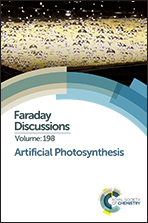Photo-driven electron transfer from the highly reducing excited state of naphthalene diimide radical anion to a CO2 reduction catalyst within a molecular triad†
Abstract
The naphthalene-1,4:5,8-bis(dicarboximide) radical anion (NDI−˙), which is easily produced by mild chemical or electrochemical reduction (−0.5 V vs. SCE), can be photoexcited at wavelengths as long as 785 nm, and has an excited state (NDI−˙*) oxidation potential of −2.1 V vs. SCE, making it a very attractive choice for artificial photosynthetic systems that require powerful photoreductants, such as CO2 reduction catalysts. However, once an electron is transferred from NDI−˙* to an acceptor directly bound to it, a combination of strong electronic coupling and favorable free energy change frequently make the back electron transfer rapid. To mitigate this effect, we have designed a molecular triad system comprising an NDI−˙ chromophoric donor, a 9,10-diphenylanthracene (DPA) intermediate acceptor, and a Re(dmb)(CO)3 carbon dioxide reduction catalyst, where dmb is 4,4′-dimethyl-2,2′-bipyridine, as the terminal acceptor. Photoexcitation of NDI−˙ to NDI−˙* is followed by ultrafast reduction of DPA to DPA−˙, which then rapidly reduces the metal complex. The overall time constant for the forward electron transfer to reduce the metal complex is τ = 20.8 ps, while the time constant for back-electron transfer is six orders of magnitude longer, τ = 43.4 μs. Achieving long-lived, highly reduced states of these metal complexes is a necessary condition for their use as catalysts. The extremely long lifetime of the reduced metal complex is attributed to careful tuning of the redox potentials of the chromophore and intermediate acceptor. The NDI−˙–DPA fragment presents many attractive features for incorporation into other photoinduced electron transfer assemblies directed at the long-lived photosensitization of difficult-to-reduce catalytic centers.
- This article is part of the themed collection: Artificial Photosynthesis


 Please wait while we load your content...
Please wait while we load your content...